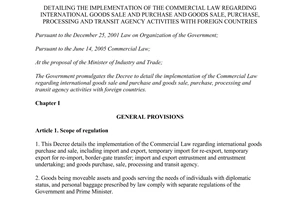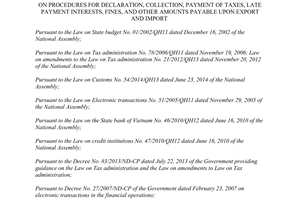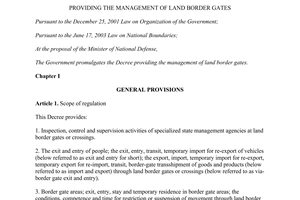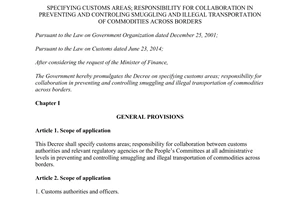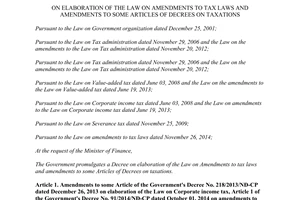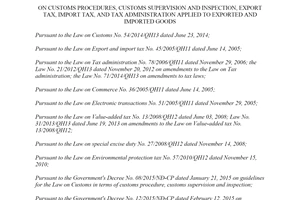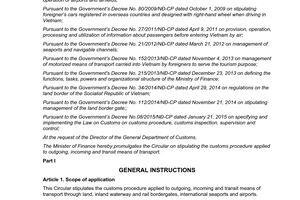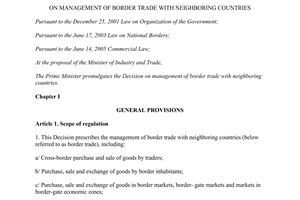Circular 217/2015/TT-BTC guiding customs procedures tax administration trade activities border residents đã được thay thế bởi Circular 80/2019/TT-BTC customs procedures tax administration fees charges with respect to export và được áp dụng kể từ ngày 01/01/2020.
Nội dung toàn văn Circular 217/2015/TT-BTC guiding customs procedures tax administration trade activities border residents
|
THE MINISTRY
OF FINANCE |
SOCIALIST
REPUBLIC OF VIETNAM |
|
No. 217/2015/TT-BTC |
Hanoi, December 31, 2015 |
CIRCULAR
GUIDING CUSTOMS PROCEDURES AND TAX ADMINISTRATION OF BORDER TRADE ACTIVITIES OF TRADERS AND BORDER RESIDENTS UNDER THE PRIME MINISTER’S DECISION NO. 52/2015/QD-TTG OF OCTOBER 20, 2015[1]
Pursuant to June 23, 2014 Law No. 54/2014/QH13 on Customs;
Pursuant to November 29, 2006 Law No. 78/2006/QH10 on Tax Administration; November 20, 2012 Law No. 21/2012/QH13 Amending and Supplementing a Number of Articles of the Law on Tax Administration; and November 26, 2014 Law No. 71/2014/QH13 Amending and Supplementing a Number of Articles of the Laws on Taxes;
Pursuant to June 14, 2005 Commercial Law No. 36/2005/QH 11;
Pursuant to the Government’s Decree No. 08/2015/ND-CP of January 21, 2015, detailing, and providing measures to implement, the Customs Law regarding customs procedures, inspection, supervision and control;
Pursuant to the Government’s Decree No. 12/2015/ND-CP of February 12, 2015, detailing the implementation of the Law Amending and Supplementing a Number of Articles of the Laws on Taxes and amending and supplementing a number of articles of the Decrees on Taxes;
Pursuant to the Government’s Decree No. 187/2013/ND-CP of November 20, 2013, detailing the implementation of the Commercial Law regarding international goods purchase and sale and goods purchase, sale, processing and transit agency activities with foreign countries;
Pursuant to the Government’s Decree No. 112/2014/ND-CP of November 21, 2014, on the management of land border gates;
Pursuant to the Government’s Decree No. 01/2015/ND-CP of January 2, 2015, detailing the scope of areas of customs operation, and responsibilities for coordination in prevention and combat of transboundary smuggling and illegal transportation of goods;
Pursuant to the Prime Minister’s Decision No. 52/2015/QD-TTg of October 20, 2015, on management of border trade activities with bordering countries;
Pursuant to the Government’s Decree No. 215/2013/ND-CP of December 23, 2013, defining the functions, tasks, powers and organizational structure of the Ministry of Finance;
At the proposal of the General Director of Customs;
The Minister of Finance promulgates the Circular providing customs procedures and tax administration of border trade activities of traders and border residents as follows:
Chapter I
GENERAL PROVISIONS
Article 1. Scope of regulation
This Circular guides customs procedures, customs inspection and supervision, and tax administration of imports, exports and vehicles on entry or exit in border trade activities; and customs procedures, customs inspection and tax administration of repurchase and transportation of goods purchased, sold and exchanged by traders and border residents.
Article 2. Subjects of application
1. Organizations and individuals engaged in border trade activities.
2. Border residents purchasing, selling and exchanging goods across border at border gates, border-gate markets, border markets and markets in border-gate economic zones.
3. Customs offices, and agencies and organizations managing and administering border trade activities.
4. Other agencies, organizations and individuals involved in border trade activities under this Circular.
Chapter II
CUSTOMS PROCEDURES, CUSTOMS SUPERVISION AND TAX ADMINISTRATION OF IMPORTS AND EXPORTS IN BORDER TRADE ACTIVITIES, AND REPURCHASE AND TRANSPORTATION OF GOODS PURCHASED, SOLD AND EXCHANGED BY TRADERS AND BORDER RESIDENTS
Article 3. Customs procedures and tax administration for traders importing and exporting goods across border
1. Customs procedures for goods imported and exported across border by traders must comply with the Ministry of Finance’s Circular No. 38/2015/TT-BTC of March 25, 2015, and traders shall fulfill the tax obligations under the current law on tax administration.
2. Goods imported and exported across border by traders must comply with the law on commodity policies, quarantine, and quality and food safety inspection.
3. Traders being business households registered under the law on business registration shall register their tax identification numbers before carrying out customs procedures.
Article 4. Customs procedures and tax administration of goods purchased, sold and exchanged by border residents through border gates or border crossings
1. For purchased, sold and exchanged goods, border residents shall fill in a border residents’ imports declaration and exports declaration (made according to the forms issued together with this Circular). Customs offices (or border guards) shall print these declarations according to set forms and distribute them to border residents.
2. The border-gate Customs Branch shall make certification on a border residents’ goods declaration as follows: The declaration-receiving officer shall give his/her signature and append a seal in the top right corner of the declaration; the officer conducting physical inspection of goods and the officer calculating and collecting taxes shall give their signatures and append seals at the bottom of the declaration in the section reserved for the customs office.
3. For goods on the list of goods purchased, sold and exchanged by border residents in excess of the duty-free limit provided in the Prime Minister’s Decision No. 52/2015/QD-TTg the border-gate Customs Branch shall calculate taxes in the border residents’ goods declaration and collect taxes right at border gates or border crossings.
4. For goods outside the list of purchased, sold and exchanged goods, border residents shall declare them on the border residents’ goods declarations and comply with regulations on commodity policies; the border-gate Customs Branch shall calculate and collect taxes right at border gates or border crossings.
5. For border gates where no treasury offices are available for tax collection, the customs office shall write a receipt and directly collect taxes; the tax amount collected from taxpayers shall be remitted into the state budget under Article 10 of the Ministry of Finance’s Circular No. 126/2014/TT-BTC of August 28, 2014.
6. Goods purchased, sold and exchanged through border gates by border residents are subject to quarantine, food safety inspection and quality control under Article 16 of the Prime Minister’s Decision No. 52/2015/QD-TTg of October 20, 2015.
7. For goods which are imported by border residents within the duty-free limit but not used for daily life and production, their resale shall be enclosed with the border residents’ goods declarations for repurchasing traders to make registration and declaration with customs offices under Article 6 of this Circular.
8. For border gates or border crossings where no customs offices are available, border guards shall manage them under Article 51 of the Customs Law; procedures, inspection and certification must comply with the guidance provided in Clauses 1 thru 6 of this Article.
Article 5. Customs procedures for goods purchased and sold across border by traders or business households at border-gate markets, border markets and markets in border-gate economic zones
1. Traders fully meeting the conditions provided in Article 18 of Decision No. 52/2015/QD-TTg that purchase, sell or exchange goods at border-gate markets, border markets and markets in border-gate economic zones shall, when importing or exporting goods, register declarations and undergo customs procedures at border-gate Customs Branches.
2. Traders that import goods from a bordering country into a market or export goods from a market to a bordering country shall, when conducting customs procedures, make a paper customs declaration (according to the form provided in Appendix IV to Circular No. 38/2015/TT-BTC) Customs procedures and tax administration must comply with the Government’s Decree No. 08/2015/ND-CP of January 21, 2015, and Circular No. 38/2015/TT-BTC of March 25, 2015.
3. Traders from a bordering country that possess a business registration certificate granted in such country, if having no branch or representative office in Vietnam under law and possessing no business registration certificate granted by a competent Vietnamese agency under regulations, shall conduct import or export procedures through customs agents.
4. Goods imported from a bordering country into a market or exported from a market to a bordering country, which are subject to health, animal, plant or aquatic product quarantine or quality and food safety inspection, must completely undergo quarantine and quality and food safety inspection procedures as prescribed before customs clearance.
Article 6. Customs procedures and tax administration for repurchase of goods of border residents
1. When repurchasing goods of border residents at border markets, border-gate markets and markets in border-gate economic zones, traders shall make a list of repurchased goods and fill in a paper declaration (made according to the form provided in Appendix IV to the Ministry of Finance’s Circular No. 38/2015/TT-BTC of March 25, 2015).
2. Customs procedures, tax administration policies, quarantine and quality inspection must comply with current regulations. A dossier must comprise:
2.1. A paper customs declaration (made according to the form provided in Appendix IV to the Ministry of Finance’s Circular No. 38/2015/TT-BTC of March 25, 2015);
2.2. A detailed list of the quantity of repurchased goods of border residents’ goods declarations, bearing a signature of the repurchasing trader (made according to the form issued together with this Circular);
2.3. Border residents’ goods declarations;
2.4. Written certifications of quarantine and quality inspection (for goods subject to quarantine and quality inspection).
3. Places for repurchase: border gates, border markets, border-gate markets and markets in border-gate economic zones provided in Clause 2, Article 15 of Decision No. 52/2015/QD-TTg.
4. Places for customs clearance: Traders repurchasing goods of border residents shall make customs registration and declaration at border-gate Customs Branches where border-gate markets, border markets or markets in border-gate economic zones are available; at joint control stations established under the Prime Minister’s decisions; or at Customs Branches where border residents import the goods; the time limit for customs clearance is 30 days after the date of repurchase.
5. Traders repurchasing goods of border residents may sell or transport the repurchased goods from border gates or markets into the inland only after completing customs procedures, fully paying taxes and fulfilling other obligations under law. They may use the cleared customs declarations as documents for circulation and transportation of goods into the inland.
6. Border-gate Customs Branches shall carry out procedures and collect all taxes (if any) at the stage of importation, and keep the border residents’ goods declarations together with dossiers of the goods lots repurchased by traders under regulations.
7. Goods repurchased by traders from border residents shall be gathered to facilitate goods inspection at border gates, traders’ warehouses and storing yards in border areas, places for centralized inspection or places for goods gathering and inspection in border areas, or other places recognized or established in border areas by customs offices.
8. In traders’ warehouses or storing yards, repurchased goods having undergone procedures shall be stored separately from repurchased goods not yet undergoing procedures to facilitate the inspection and control by functional agencies when necessary.
Article 7. Customs supervision of goods purchased, sold and exchanged through border gates by traders, business households and border residents
1. Principles of supervision and certification of goods going through customs supervision areas for traders and business households are as follows:
1.1. If the declaration is made in the automated customs clearance system: The border-gate Customs Branch shall certify goods going through the customs supervision area in the system only when exports have been transported across border and imports have been certified as eligible for being brought out of the customs supervision area.
1.2. If the declaration is made on paper (according to the form provided in Appendix IV to Circular No. 38/2015/TT-BTC and the forms of border residents’ imports and exports declarations issued together with this Circular): The customs officer shall give his/her signature, append the officer seal and write the date of declaration in the box “certification by supervision officer” of the import declaration and export declaration, or give certification in the physical inspection section of the border residents’ imports and exports declarations.
1.3. The customs officer conducting supervision at border gates shall check and compare information in the customs declaration of goods already certified as eligible for being brought out of the customs supervision area with the actual state of imports and exports.
2. Handling of supervision results:
2.1. If the inspection and comparison results are consistent, the customs officer shall supervise goods brought out of the customs supervision area; certify in the system that the goods have gone through the customs supervision area or give his/her signature, append the officer seal and write the date of handling in box 31 of the exports declaration and box 36 of the imports declaration (for paper declarations).
2.2. In case the inspection results are inconsistent, the customs officer shall not permit the goods to be exported or brought out of the customs supervision area; report such to the head of the Customs Branch for directing the cancellation of certification in the system (if the certification has been made), clarify the case and handle violations (if any) under law.
3. Customs supervision of goods purchased, sold and exchanged through border gates by border residents:
3.1. In case the goods are on the duty-free list and within the duty- free limit, the customs officer shall personally conduct supervision at border gates and make certification in the physical inspection section of the border residents’ imports declaration.
3.2. In case the goods are outside the duty-free list and exceed the duty-free limit, the customs officer shall personally conduct inspection at border gates, and make certification in the physical inspection section and the section for tax calculation and collection of the border residents’ imports declaration.
Chapter III
CUSTOMS INSPECTION AND SUPERVISION AND STATE MANAGEMENT OF THE MANAGEMENT OF PURCHASE, SALE AND EXCHANGE OF GOODS BY BORDER RESIDENTS AND VEHICLES FREQUENTLY TRAVELING ACROSS BORDER
Article 8. Customs inspection
1. Goods purchased, sold and exchanged by border residents through border gates are subject to inspection and supervision of customs offices.
2. Border residents’ goods which are outside the list of goods purchased, sold and exchanged by border residents and exceed the duty- free limit prescribed in the Decree guiding the Law on Import Duty and Export Duty, are subject to physical inspection upon customs clearance. In the course of physical inspection of goods, if seeing it necessary to change the form of inspection, the head of the Customs Branch conducting inspection shall decide on change.
3. Goods purchased and sold across border by traders, and goods repurchased by traders from border residents are subject to customs inspection under Article 29 of the Government’s Decree No. 08/2015/ND-CP of January 21, 2015, and legal documents on customs inspection.
Article 9. Customs offices’ state management of goods purchased, sold and exchanged by border residents
1. The General Department of Customs shall coordinate with units under the Ministry of Industry and Trade, the Ministry of National Defense and the Ministry of Agriculture and Rural Development, and related units in guiding and managing border trade activities in accordance with law.
2. To develop a software for management of goods purchased, sold and exchanged by border residents on the basis of barcodes integrated in border identity cards, border residents’ laissez-passers or other papers permitting residents to travel across border.
3. To develop a software for tax administration and calculation of border residents’ declarations which satisfy the conditions specified in Article 14 of Decision No. 52/2015/QD-TTg of October 20, 2015, conduct tax administration and calculation, and print border residents’ declarations according to the import declaration form and export declaration form issued together with this Circular. The software for tax administration and calculation shall be connected to the software for management of border residents’ declarations for tax calculation and collection.
4. To install computers and barcode scanners to facilitate the management by customs offices and create favorable conditions for border residents.
5. For border gates without software and barcode scanners installed for management of border residents, border-gate Customs Branches shall open a book for monitoring border residents’ goods (made according to the form issued together with this Circular).
6. To update information of paper customs declarations onto the system: Border-gate Customs Branches shall update sufficient information on importers, exporters, tax identification numbers, purchase and sale contracts (if any), dates, serial numbers of declaration forms, goods appellations, quantity and value, and payable tax amounts, and transmit such information to the General Department of Customs at the end of the day.
7. The General Department of Customs shall establish a price database based on the list of goods purchased, sold and exchanged by border residents to serve the consultation and reference when necessary.
8. The paper customs declaration shall be filled under Article 25 of the Government’s Decree No. 08/2015/ND-CP of January 21, 2015. Paper declarations made according to the form provided in Appendix IV to Circular No. 38/2015/TT-BTC and border residents’ exports declarations provided in this Circular may not be used as documents for value-added tax refund.
Article 10. Customs inspection and supervision of vehicles of individuals and organizations traveling across border
1. Procedures for, and inspection and supervision of, vehicles of individuals and organizations entering border areas for goods delivery and receipt under Article 81 of the Government’s Decree No. 08/2015/ND-CP of January 21, 2015, and Article 33 of the Ministry of Finance’s Circular No. 42/2015/TT-BTC of March 27, 2015, on customs procedures for vehicles on entry or exit, shall be carried out.
1.1. Vehicles of individuals, agencies and organizations in a border area which frequently travel across border are subject to single registration with the customs office; the border-gate Customs Branch shall open a vehicle management book (made according to the form issued together with this Circular), with the following information: vehicle driver (or vehicle owner), residence address, number of personal identification paper (identity card, laissez-passer, etc.), type of vehicle, and number plate of vehicle (if any).
1.2. If transporting imports and exports, the vehicle driver shall produce to the customs office the imports and exports declarations already cleared from customs procedures.
2. Tasks of officers supervising vehicles of organizations and individuals traveling across border: To prevent, detect and handle acts of smuggling and illegal transboundary transportation of goods, ensuring that customs procedures and inspection are conducted under regulations for imports and exports going across border.
Chapter IV
ORGANIZATION OF IMPLEMENTATION
Article 11. Implementation responsibility
1. The General Director of Customs shall, pursuant to this Circular, guide customs offices for unified implementation in order to create favorable conditions for border trade activities and properly perform the customs management.
2. Competent customs offices shall implement provisions on customs procedures, customs inspection and supervision, import duty and export duty, and tax administration of purchased, sold and exchanged goods under this Circular. Customs offices, customs declarants and taxpayers shall report problems arising in the course of implementation to the Ministry of Finance (the General Department of Customs) for consideration, guidance and settlement on a case-by-case basis.
3. In the course of implementation, if relevant documents referred to in this Circular are amended, supplemented or replaced, the amending, supplementing or replacing documents shall prevail.
Article 12. Effect
This Circular takes effect 45 days from the date of its signing. To annul Article 94 of the Ministry of Finance’s Circular No. 38/2015/TT-BTC of March 25, 2015, Document No. 1883/BTC-TCHQ of February 19, 2009, and Document No. 195/BTC-TCHQ of January 6, 2011, on customs procedures and tax administration of border trade activities.-
|
|
FOR THE
MINISTER OF FINANCE |
* All appendices and forms issued together with this Circular are not translated.
[1] Công Báo Nos 169-170 (08/2/2016)


